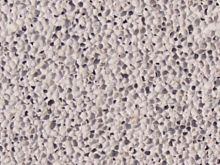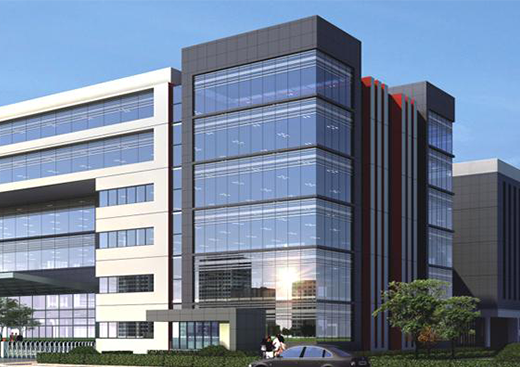

Overview of lightweight concrete
Lightweight concrete, also known as foamed concrete, is to fully foam the foaming agent mechanically through the foaming system of the foaming machine, mix the foam and cement slurry evenly, and then pass the pumping system of the foaming machine for in-situ construction Or mold forming, a new type of lightweight thermal insulation material with a large number of closed pores formed by natural curing. It is a bubble-shaped heat-insulating material, and its outstanding feature is the formation of closed foam cells inside the concrete, which makes the concrete lightweight and heat-insulating; it is also a special variety in aerated concrete, and its pore structure and material properties are close For aerated concrete, the difference between the two is only the difference between the shape of the pores and the means of aerated concrete.
Lightweight concrete is commonly used in many engineering constructions, and lightweight concrete refers to concrete made of lightweight coarse and fine aggregates and cement. Lightweight concrete is a general term for concrete with a bulk density not greater than 1950kg/m3. So what type of lightweight concrete is included?
There are three main categories of lightweight concrete
1. The apparent density of lightweight aggregate concrete is 800~1950 kg/m3. Lightweight aggregates include pumice, volcanic slag, ceramsite, expanded perlite, expanded slag, slag, etc.
2. Hollow concrete (foamed concrete, aerated concrete), its apparent density is 300-1000 kg/m3. Foamed concrete is made of cement paste or cement mortar and stabilized foam. Aerated concrete is made of cement, water and gas generating agent.
3. Macroporous concrete (ordinary macroporous concrete, light aggregate macroporous concrete) has no fine aggregate in its composition. The apparent density of ordinary macroporous concrete ranges from 1500 to 1900 kg/m3 and is prepared from crushed stone, soft stone and heavy slag as aggregates. The apparent density of light aggregate macroporous concrete is 500-1500 kg/m3, and it is made of ceramsite, pumice, broken brick, slag, etc.
Application of lightweight concrete
Lightweight concrete is widely used in energy-saving wall materials due to its good characteristics, and has also been used in other areas. At present, the application of lightweight concrete in China is mainly cast-in-place roof insulation, lightweight wall panels, and compensation foundations. However, making full use of the good characteristics can continuously expand its application in construction engineering, speed up the progress of the project, and improve the quality of the project. The details are as follows:
⑴Used as a retaining wall. Mainly used as a rock wall for the port. Used as a lightweight backfill material behind the quay wall can reduce the vertical interception load and also reduce the lateral load on the quay wall. This is because it is a rigid body with good bonding performance. It does not exert lateral pressure on the quay wall along the periphery, and the settlement is reduced, and the maintenance cost is reduced, thereby saving a lot of expenses. Foamed concrete can also be used to improve the stability of the embankment slope. It can replace part of the soil on the slope. As it reduces the quality, it reduces the force that affects the stability of the slope.
(2) Construct sports fields and track and field tracks. Use permeable foamed concrete with strong drainage capacity as a lightweight foundation, covered with gravel or artificial turf, as a sports field. The density of foam concrete is 800-900kg/m³ such sports fields can be used for hockey, football and tennis activities. Or it can be used as a track and field track if it is covered with a 0.05m thick porous asphalt layer and a plastic layer on the foam concrete.
⑶As a sandwich component. Lightweight concrete can be used as the inner core in the prefabricated reinforced concrete components, so that it has good performance of light weight, high strength and heat insulation. Foamed concrete with a density of 400-600kg/m³ is usually used.
⑷ Pipeline backfilling. Underground abandoned oil tanks, pipelines (with crude oil, chemicals), sewage pipes and other cavities are likely to cause fires or collapses. Using foam concrete backfilling can solve these problems, and the cost is low. The density of foam concrete depends on the diameter of the pipe and the groundwater level, generally 600-1100kg/m³.
⑸ Lean concrete filling layer. Due to the use of flexible hoses, foam concrete has great workability and adaptability, so it is often used for lean concrete fills. If the requirement for thermal insulation is not very high, use a density of 1200kg/m³ the lean concrete fill layer with an average thickness of 0.05m; if the requirement for thermal insulation is very high, use the lean concrete with a density of 500kg/m³ The filling layer has an average thickness of 0.1-0.2m.
⑹ Roof slope. Foamed concrete is used for roof slopes and has the advantages of light weight, fast construction speed, and low price. The slope is generally 10mm/m. The thickness is 0.03-0.2m, and the foam concrete with a density of 800-1200kg/m³ is used.
⑺ Support for the bottom of the storage tank. The foam concrete is poured on the bottom of the steel storage tank (with crude oil and chemicals). If necessary, a convex foundation can be formed. This can ensure that the support of the entire tank bottom is in the best stress state during welding. A continuous support allows the storage tank to adopt a thin plate bottom. At the same time, the convex foundation is easy to clean. The use density of foam concrete is 800-1000kg\m³.
⑻Used for landscaping. The foam concrete is made into a bulk density of 600-1000kg/m³ it can be used for garden rockery, garbage bins, tables and stools, etc.
⑼ National defense (modern warfare uses information and advanced mobile equipment as attack tools). The foamed cement can be used in military projects destroyed by enemy bombing, such as airports and important traffic roads. The project destroyed by the enemy was quickly repaired, and the result of the experiment was that it could be used for aircraft taking off and landing within 10 minutes after repairing, and the tanks passed.
⑽Others. Foamed concrete can also be used for insulation filling of firewalls, sound insulation floor filling, tunnel lining backfilling, and power supply and water pipeline isolation.
The price of lightweight concrete
The price of lightweight concrete varies randomly with production costs, transportation costs, international conditions, exchange rates, and the market supply and demand of lightweight concrete. Tanki New Materials Co. Ltd aims to help all industries and chemical wholesalers find high-quality products by providing a full range of products. If you are looking for lightweight concrete, please contact us for the latest price of lightweight concrete.
Supplier of lightweight concrete
As a global supplier of lightweight concrete, Tanki New Materials Co., Ltd. Has extensive experience in the performance, application and cost-effective manufacturing of advanced and engineering materials. The company has successfully developed a series of foam concrete additives (including lightweight concrete, CLC blocks provide concrete foaming agents, superplasticizers, foam concrete strength enhancers, etc.), high-purity targets, and functional materials. Ceramics and structural equipment, and provide OEM services.
Tanki New Materials Co.Ltd Aims to help All industries and Chemical Wholesalers to find high quality, cheap price nano materials and chemicals by providing turn-key customize manufacturing services.
As a trust-worthy
global nano-materials and chemicals manufacturer, Tanki New Materials Co.Ltd has been successfully supplying big and small brands with customized nano materials and chemical products in bulk or small quantities.
Tanki New
Materials Co.Ltd has rich experiences in the properties, applications, and cost-effective manufacturing of advanced and engineered materials. The company has successfully developed a series of powder materials (including oxides, carbides,
nitrides, single metal, etc.), high-purity targets, functional ceramics, and structural devices. OEM service is available.
Our innovative, high-performance materials are widely used in many industries, including but not limited
to the automotive, electrical, electronics, information technology, petrochemical, oil, ceramics, paint, metallurgy, solar energy, and catalysis.
Based in the center of China, the company has rich resources and chemical product
manufacuturing chains to make sure your cost remain as low as your specifications demand.
The company provides following products such as providing super high quality chemicals and Nano materials such as graphite powder,
boron powder , zinc sulfide , nitride powder, Calcium nitride, Ca3N2, 3D printing powder, and so on.

Ask a quote for the latest price and one of our team members will respond as soon as possible. Fields marked with * are required.
